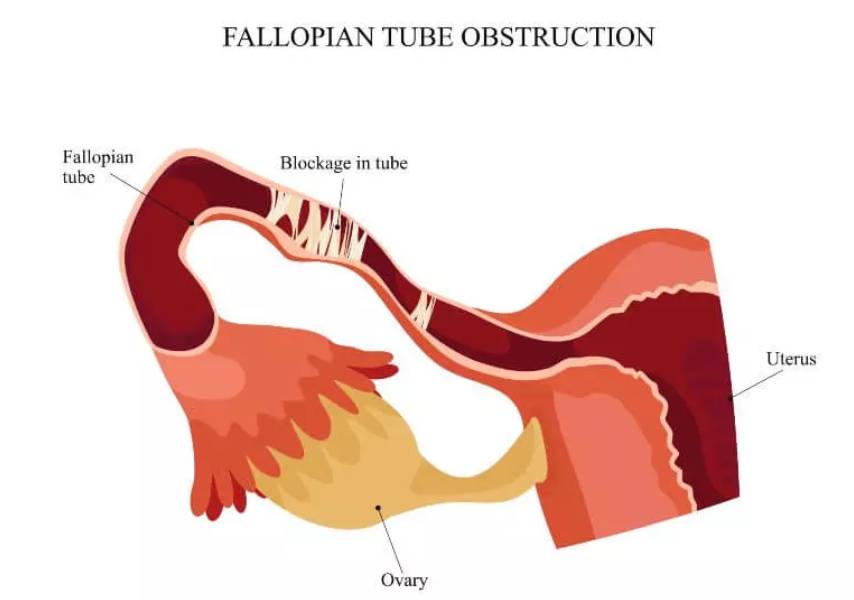- kapilkanade@yahoo.com
- SUNSHINE IVF and Endoscopy, Hadapsar, Pune

The fallopian tubes are two narrow tubes that carry mature eggs from the ovaries to the uterus, and are very important in the fertilization process. Fertilization usually takes place as the egg moves along these tubes to the uterus. But in case of a blocked fallopian tube, the egg is unable to move to the uterus, thus preventing fertilization and consequently causing infertility. Both unilateral (one tube) and bilateral (two tubes) blockages have a significant effect on fertility, with obstruction of the tubes being one of the most common causes of female infertility, occurring in about 40% of cases.
Causes of Blocked Fallopian Tubes
There are various factors that may cause blockage of the tubes, including:
History of Ectopic Pregnancy
Symptoms of Tubal Blockage
Symptoms of obstructed fallopian tubes can be different and in certain cases may not manifest immediately. The most common indicators are:
One needs to recognize the fact that while some women have blocked fallopian tubes and may fail to conceive as expected, it is still possible for them to continue ovulating.
Treatment Procedures for Blocked Fallopian Tubes
Single Obstruction of one Tubal Section
When there is a single fallopian tube blockage, the treatment is usually simpler. Fertility doctors tend to prescribe medicines that stimulate ovulation to increase the likelihood of conception via the unobstructed tube.
Bilateral Tubal Blockage
When both fallopian tubes are occluded, fertility drugs by themselves are not enough. Laparoscopic surgery is the best option in this instance. This surgery will either remove the blockage or shave off the tissue which is responsible for the blockage. The success rate of this surgery is greater in younger females.
In Vitro Fertilization (IVF)
IVF is the most successful therapy for blocked fallopian tubes and is generally the last option for women to have a baby despite this. With IVF, fertilization takes place outside the body and avoids the use of the fallopian tubes altogether, thus providing a valid solution for people with tubal infertility.
Ectopic Pregnancy Treatment
In order for a pregnancy to occur, the ovary needs to release an egg into the fallopian tube, where it can survive for about 24 hours. Fertilization will occur if the egg meets a sperm during this period. The egg after fertilization stays in the fallopian tube for three to four days before moving on to the uterus, where it implants into the uterine lining and grows until birth.
But in other instances, the fertilized egg implants outside the uterus, typically in the fallopian tube or, less often, elsewhere in the abdominal cavity. Such a pregnancy is referred to as an ectopic pregnancy, which cannot develop normally and must be treated medically right away.
Symptoms of Ectopic Pregnancy
Ectopic pregnancies usually happen in the early weeks of conception, before a woman knows she is pregnant. Early symptoms can be:
If untreated, an ectopic pregnancy can rupture the fallopian tube, causing extreme pain and bleeding inside. Immediately go to the hospital if you notice heavy bleeding from the vagina, dizziness, fainting, or sharp chest pain.
Causes and Risk Factors
Although the precise reason for an ectopic pregnancy is usually not known, a scarred or blocked fallopian tube may hinder the fertilized egg from entering the uterus, resulting in incorrect implantation. A number of factors may contribute to an increased risk of ectopic pregnancy, such as:
A history of ectopic pregnancy
Diagnosis of Ectopic Pregnancy
To diagnose an ectopic pregnancy, a healthcare professional may conduct the following tests:
Treatment Options
Because a fertilized egg can't live outside the uterus, it must be removed to avoid serious complications. The following treatment options are available:
Medication
If the fallopian tube isn't ruptured and the pregnancy is in its beginning stages, methotrexate (Trexall) is injected. This drug halts cell growth so the body will naturally absorb the tissue. Methotrexate works in the majority of ectopic pregnancies that are in early stages.
Surgical Intervention
If medication cannot be used, or if the fallopian tube is damaged, then surgery will have to be performed. Laparoscopy is the most frequently used procedure, whereby minor cuts are made in the abdomen, and a flexible, thin device (laparoscope) is inserted to drain the ectopic pregnancy. When the fallopian tube is badly damaged, removal might also have to be done.
For more severe cases, such as those involving heavy internal bleeding or a ruptured fallopian tube, emergency surgery (laparotomy) is done with a larger incision.
Recovery and Future Pregnancy
Patients who have a laparoscopic procedure can typically go home the same day and return to normal activities within 24 hours, with complete recovery within several days or four weeks, depending on an individual's healing.
Although an ectopic pregnancy can influence future fertility, most people continue to have a successful pregnancy. It is best to see a fertility specialist, especially if one of the fallopian tubes has been surgically removed. Physicians usually advise waiting three to six months before trying again. Having had an earlier ectopic pregnancy, though, raises the risk of another one occurring.
Dr. Kapil Kanade, a highly experienced laparoscopic surgeon from Maharashtra, has successfully conducted more than 450 ectopic pregnancy operations. With his skill in minimally invasive surgery, patients are provided with quality care, resulting in the best possible results.
For expert consultation and professional treatment, book an appointment with Dr. Kapil Kanade today
Book a Visit TodayExperience
Happy Patients
Infertility
IUI